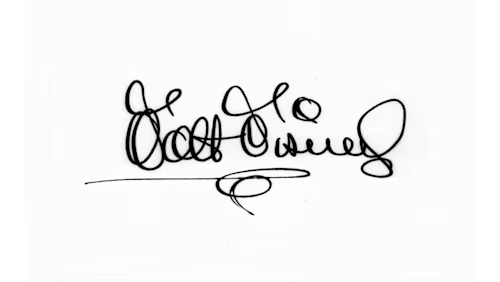
A Look Back at the History of the Humble Signature
Curious to know who penned the first recorded signature? Or why signatures exist at all? Let’s take a look back at the history of the humble signature.

When you add your digital squiggle to a contract, do you ever stop to wonder why you need to leave your mark? Or how signatures became such a recognisable way of confirming people’s identity? Maybe you don’t think about these things — but here at DocuSign, we do. After all, signatures are in our DNA.
So we thought we’d get a little nerdy on you and share a brief history of the humble signature.
Before we turn back the clock, though, let’s recap on what a signature actually is. According to Wikipedia, the word ‘signature’ comes from the Latin word ‘signare’, which means ‘to sign’. It’s defined as a handwritten (and often stylised) depiction of someone’s name, nickname, or even a simple ‘X’ or other mark that a person writes on documents as a proof of identity and intent. And, for centuries, people have wanted to prove themselves.
Making their mark in Mesopotamia
Some of the earliest recorded signatures (or stamps) are from Mesopotamia. This was way back in around 3100 BC, an era well before pens or paper existed. The Sumerians wanted a way to verify ownership of their clay tablets, so they invented seals — little cylinders with pictures or symbols carved into them, which they would roll onto the wet clay to leave a distinguishing mark.
Ancient Egyptians used a similar technique to prove their identity. Around 3000 BC, they worked out a way to use the pith of a papyrus plant as a paper-like material, and they started writing on these papyrus scrolls. On official documents, they would stamp them with hieroglyphs or cartouches to prove ownership and authenticity.
Signums start showing up in Europe
During the Middle Ages, across Europe, people started adding symbols to contracts and correspondence to prove their identity. Given that most people couldn’t read and write, these symbols — called signums — were typically a simple cross. Basically, a mark made by a witness.
It wasn’t until 1069 that the first known document signed in the Latin alphabet was recorded. The signatory? A nobleman and military leader called El Cid, who had made a donation to the Cathedral of Valencia and wanted it known. Those who could read and write back then tended to have very elaborate signatures, full of loops and flourishes. The idea being, the more complex the signature, the harder for it to forge or fake. (While Walt Disney certainly wasn’t of this era, he definitely took a leave out of the loopy book.)

Walt Disney’s iconic signature
It wasn’t just on legal documents that signatures started appearing. During the Renaissance period, artists started signing their works to ensure they would be credited for the art they created. Fun fact: Michelangelo was a non-believer in the signature stakes. La Pietà was the only piece he ever signed — and he only did it after overhearing someone incorrectly attribute his work to another artist.
Making things legal in 1677
It wasn’t until the 17th century that signatures acquired the legal dimension they’re known for today. In 1677, the English Parliament passed the Statute of Fraud Act, which basically said that certain contracts — like wills, contracts and grants — needed to be signed to be considered valid.
The rise of the printing press and widespread literacy further reinforced the importance of signatures. By the 18th century, signing your name was a common practice across many cultures. And it has remained the gold standard for legal documents and the verification of people’s identity.
Going digital in the 21st century
Now, here we are in the 21st century, living in a digital-first world — and electronic signatures are more commonplace than pen-and-paper ones. The rise of the electronic signature coincided with the ESign Act in 2000 in the United States, and the founding of DocuSign in 2003.
Today, eSignatures are widely recognised as a highly secure, legally binding way to identify a person on a document. Features like signer ID verification and a tamper-proof audit trail make electronic signatures even more robust than pen-and-paper ones, which have often fallen victim to forgeries. Not to mention the speed and convenience of being able to sign documents on a digital device instead of having to print them out.
What’s next for the humble signature? Who knows? As long as we humans need a way to leave our mark on important documents — and to reliably verify our identities — then the signature will remain part of our lives. But, as history has taught us, what that little squiggle looks like could very well change again over time.
Docusign IAM is the agreement platform your business needs

